Contests
A
Little Friendly Competition
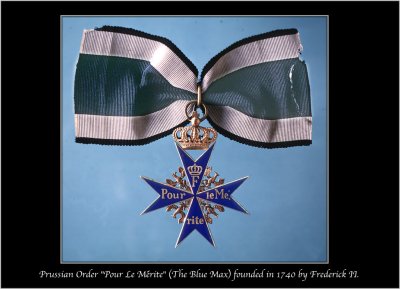 The
world will never improve without competition. I contend that laziness
(not necessity) is the mother of invention and competition improves
and hones it to a fine edge. FAC members like to get together for a
little friendly competition with the outlook for a little recognition
and more importantly, camaraderie. A contest or event is invoked whereby
three or more FAC members compete with a similar class of flying model.
The first place winner is awarded a “Kanone” in the same
way that a German WWI aviator was after scoring a victory. Second, third,
and sometimes fourth place finishers get to bathe in the glory of the
attempt at battle (okay, they win first, second, and third loser). Kanone
is German World War I aviator jargon for “big cannon” which
could be thought of as “hotshot” or “Ace” in
America. Once a German pilot received 16 kanones (eight originally)
he was awarded the “Blue Max”. The Flying Aces club tracks
kanones awarded at the local and national level, and once sixteen are
obtained, the member is awarded a reproduction Blue Max medal as well.
This is a good time to bring up rank within the FAC. When you join,
you are commissioned a First Lieutenant. You become promoted upwards
in the ranks as you accumulate kanones. The
world will never improve without competition. I contend that laziness
(not necessity) is the mother of invention and competition improves
and hones it to a fine edge. FAC members like to get together for a
little friendly competition with the outlook for a little recognition
and more importantly, camaraderie. A contest or event is invoked whereby
three or more FAC members compete with a similar class of flying model.
The first place winner is awarded a “Kanone” in the same
way that a German WWI aviator was after scoring a victory. Second, third,
and sometimes fourth place finishers get to bathe in the glory of the
attempt at battle (okay, they win first, second, and third loser). Kanone
is German World War I aviator jargon for “big cannon” which
could be thought of as “hotshot” or “Ace” in
America. Once a German pilot received 16 kanones (eight originally)
he was awarded the “Blue Max”. The Flying Aces club tracks
kanones awarded at the local and national level, and once sixteen are
obtained, the member is awarded a reproduction Blue Max medal as well.
This is a good time to bring up rank within the FAC. When you join,
you are commissioned a First Lieutenant. You become promoted upwards
in the ranks as you accumulate kanones.
Geneseo,
New York
 Every year the FAC hosts a national competition
in Geneseo, NY and on even years it's called the FAC Nats. On odd years
it's called the non-Nats. During the Nats, competitors come from all
parts of the country and even from international origins to compete
in three days of the toughest flying you’ll find anywhere. This
event typically lasts for three days. The first day we meet up at the
hotel where registration takes place, models are displayed and judged,
and vendors sell their products. There is a certain carnival atmosphere
on that first day as old friends reunite and new friendships are born
over discussions of new models, techniques, products and plans. The
number of contestants varies between 150 to 180 who register to fly
in all of the 30 plus classes available. More on the classes later.
Most competitors enter from 4 to 8 models depending on the classes they
like. The toughest competition is the one that forms the basis of the
Flying Aces Club, FAC Scale. This class is designed to encourage modelers
to build high quality scale reproductions of actual aircraft that also
fly well. The display room is usually filled with models in the judged
events only. There are more models to be seen tucked away in boxes in
hotel rooms and vehicles for the other events. Every year the FAC hosts a national competition
in Geneseo, NY and on even years it's called the FAC Nats. On odd years
it's called the non-Nats. During the Nats, competitors come from all
parts of the country and even from international origins to compete
in three days of the toughest flying you’ll find anywhere. This
event typically lasts for three days. The first day we meet up at the
hotel where registration takes place, models are displayed and judged,
and vendors sell their products. There is a certain carnival atmosphere
on that first day as old friends reunite and new friendships are born
over discussions of new models, techniques, products and plans. The
number of contestants varies between 150 to 180 who register to fly
in all of the 30 plus classes available. More on the classes later.
Most competitors enter from 4 to 8 models depending on the classes they
like. The toughest competition is the one that forms the basis of the
Flying Aces Club, FAC Scale. This class is designed to encourage modelers
to build high quality scale reproductions of actual aircraft that also
fly well. The display room is usually filled with models in the judged
events only. There are more models to be seen tucked away in boxes in
hotel rooms and vehicles for the other events.
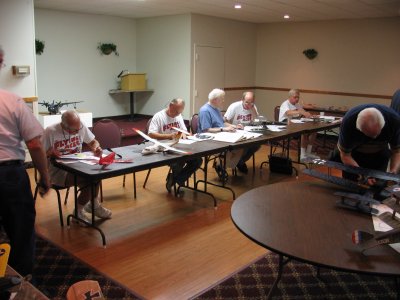 Scale
models are judged by a team of seasoned veterans who evaluate the model
on fidelity to the original aircraft outlines, coloring, and markings.
Workmanship and overall quality of the model are judged as well. Published
documentation must be provided to provide proof of your choice of aircraft
and authenticate the color scheme and markings. With over 150 competitors
entering several models to be judged, approximately 300 to 500 models
must be judged in a very short time. Sometimes, judging takes place
out at the field if the number of entries is large enough. Additional
points are accumulated during the flying phase. Points are awarded for
the length of time the aircraft remains airborn. Bonus points (handicap)
are awarded to models that are more complex or have features that would
make them more difficult to fly. For example, a biplane gets 15 bonus
points because planes with two wings are harder to fly than those with
one wing. Flight times range between 20 to 120 seconds and over, depending
on the model and the skill of the flyer. 20 seconds is the smallest
number of seconds to qualify for an official flight in most cases. Flight
times of over 40 seconds used to be rare but now it takes times in the
90’s to place in competition these days. Scale
models are judged by a team of seasoned veterans who evaluate the model
on fidelity to the original aircraft outlines, coloring, and markings.
Workmanship and overall quality of the model are judged as well. Published
documentation must be provided to provide proof of your choice of aircraft
and authenticate the color scheme and markings. With over 150 competitors
entering several models to be judged, approximately 300 to 500 models
must be judged in a very short time. Sometimes, judging takes place
out at the field if the number of entries is large enough. Additional
points are accumulated during the flying phase. Points are awarded for
the length of time the aircraft remains airborn. Bonus points (handicap)
are awarded to models that are more complex or have features that would
make them more difficult to fly. For example, a biplane gets 15 bonus
points because planes with two wings are harder to fly than those with
one wing. Flight times range between 20 to 120 seconds and over, depending
on the model and the skill of the flyer. 20 seconds is the smallest
number of seconds to qualify for an official flight in most cases. Flight
times of over 40 seconds used to be rare but now it takes times in the
90’s to place in competition these days.
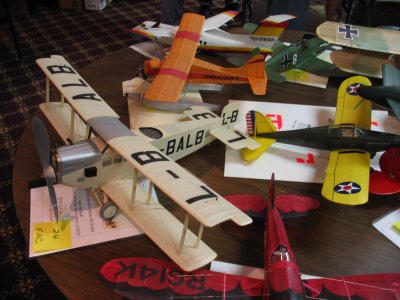 Every
kind rubber and powered (electric, gas, and diesel) model is proudly
brought out for display and flying during this three days of fun, food,
and friendship. Most people who come stay in either the local hotels
that fill up fast, or one of the dormitory rooms provided by the local
college. If you stay at the dorm, you get to eat at the cafeteria that
boasts a pretty good menu for breakfast and dinner. Lunch can be had
by purchasing hot dogs and hamburgers served by the folks who run the
museum nearby. This is one event that every FAC modeler and anyone who
loves rubber powered models has to see at least once in their lifetime. Every
kind rubber and powered (electric, gas, and diesel) model is proudly
brought out for display and flying during this three days of fun, food,
and friendship. Most people who come stay in either the local hotels
that fill up fast, or one of the dormitory rooms provided by the local
college. If you stay at the dorm, you get to eat at the cafeteria that
boasts a pretty good menu for breakfast and dinner. Lunch can be had
by purchasing hot dogs and hamburgers served by the folks who run the
museum nearby. This is one event that every FAC modeler and anyone who
loves rubber powered models has to see at least once in their lifetime.
Muncie,
Indiana
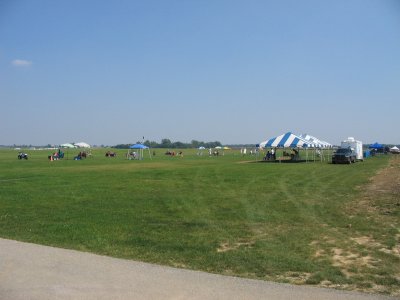 Every
year in September, a national contest is held at Muncie, Indiana, home
of the Academy of Model Aeronautics (AMA) at one of the most beautiful
and serene spots in America. Once you arrive at the site, laid out before
you is a huge verdant field surrounded by corn fields and other crops.
These cornfields have exacted their toll on numerous models so it is
wise to fly away from them if possible. Contestants can stay at one
of the hotels nearby or camp on the premises. The AMA provides amenities.
Usually, the weather is perfect in Indiana this time of year for a contest
of this caliber and people from all over the country come to participate.
This contest is a little more casual than the Nationals held in Geneseo
but the seriousness of competition and the general fun of modeling is
just as strong. There is no formal judging in an enclosed building as
the airplanes are judged on the field. Every
year in September, a national contest is held at Muncie, Indiana, home
of the Academy of Model Aeronautics (AMA) at one of the most beautiful
and serene spots in America. Once you arrive at the site, laid out before
you is a huge verdant field surrounded by corn fields and other crops.
These cornfields have exacted their toll on numerous models so it is
wise to fly away from them if possible. Contestants can stay at one
of the hotels nearby or camp on the premises. The AMA provides amenities.
Usually, the weather is perfect in Indiana this time of year for a contest
of this caliber and people from all over the country come to participate.
This contest is a little more casual than the Nationals held in Geneseo
but the seriousness of competition and the general fun of modeling is
just as strong. There is no formal judging in an enclosed building as
the airplanes are judged on the field.
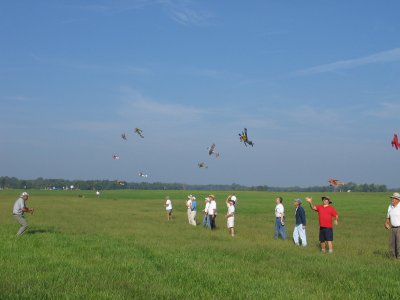 There is no doubt that competition improves the hobby.
One of the most exciting events held at FAC sponsored contests are the
mass launches. This event is characterized by having more than three
entrants who launch their models ate the same time and the last one
down wins. This doesn’t sound like much but there is much to be
said behind the scenes. Many times two airplanes will collide bringing
them both down to the ground in crumpled heaps. The remaining classes
are equally as competitive and require extensive attention to the smallest
detail. Models are required to fly a minimum of twenty seconds to qualify
for an official flight and they can be hand launched or released from
a table top or small runway. There are numerous events that are not
scale, referred to as “duration” events where models of
vintage designs and even newer designs compete for the clock. These
classes are as competitive as any and include Old Time Rubber, Old Time
Rubber Stick, embryo, Jimmie Allen and others.
There is no doubt that competition improves the hobby.
One of the most exciting events held at FAC sponsored contests are the
mass launches. This event is characterized by having more than three
entrants who launch their models ate the same time and the last one
down wins. This doesn’t sound like much but there is much to be
said behind the scenes. Many times two airplanes will collide bringing
them both down to the ground in crumpled heaps. The remaining classes
are equally as competitive and require extensive attention to the smallest
detail. Models are required to fly a minimum of twenty seconds to qualify
for an official flight and they can be hand launched or released from
a table top or small runway. There are numerous events that are not
scale, referred to as “duration” events where models of
vintage designs and even newer designs compete for the clock. These
classes are as competitive as any and include Old Time Rubber, Old Time
Rubber Stick, embryo, Jimmie Allen and others.
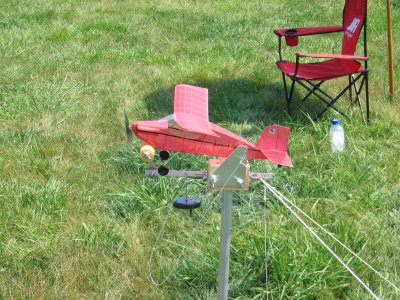 Every
airplane entered must prove it’s ability to fly well above and
beyond it’s looks. The emphasis is on flying and having fun.
The bottom line, the more the merrier. All aircraft entered in competition
must be constructed using the traditional materials for the main structural
portion of the airframe. There are some exceptions but they are usually
for trim items, wheels, and other small parts. There are some limitations
applied to the airplane, but they are not extensive. The main idea
is to promote stick and tissue construction as it was in the early
days. Every
airplane entered must prove it’s ability to fly well above and
beyond it’s looks. The emphasis is on flying and having fun.
The bottom line, the more the merrier. All aircraft entered in competition
must be constructed using the traditional materials for the main structural
portion of the airframe. There are some exceptions but they are usually
for trim items, wheels, and other small parts. There are some limitations
applied to the airplane, but they are not extensive. The main idea
is to promote stick and tissue construction as it was in the early
days.
Flying
Aces Club - General Headquarters (GHQ)
Lin Reichel
3301 Cindy Lane
Erie, PA 16506
Class Struggle
There are 30 classes of airplanes normally recognized by the FAC. They
are:
1. FAC PEANUT SCALE
2. FAC RUBBER SCALE
3. FAC JUMBO SCALE
4. FAC GIANT SCALE
5. FAC POWER SCALE
6. FAC PIONEER SCALE
7. GHQ PEANUT SCALE
8. THOMPSON RACE *
9. GREVE RACE *
10. SHELL SPEED DASH
11. AEROL RACE *
12. BENDIX RACE *
13. GOODYEAR RACE *
14. FORMULA RACE *
15. WWI COMBAT *
16. WWII COMBAT *
17. GOLDEN AGE CIVIL SCALE
18. GOLDEN AGE MILITARY
19. MODERN AGE CIVIL SCALE
20. MODERN AGE MILITARY
21. FAC JET CATAPULT SCALE
22. FAC NO-CAL PROFILE SCALE
23. FAC EMBRYO ENDURANCE
24. FAC OLD TIME STICK
25. FAC OLD TIME RUBBER
26. FAC 2-BIT OLD TIME RUBBER
27. FAC OLD TIME GAS REPLICA
28. FAC DIME SCALE
29. FAC OLD TIME KIT SCALE
30. FAC JIMMY ALLEN
31. FAC O.T. PLAN SCALE
* Denotes a mass launch event.
I'll
need to elaborate more on these classes eventually.
GENERAL
FAC RULES
The
ideals of the FAC are founded in friendly competition that promotes improvements
to the appearance and flights of our models. The intentions of the GENERAL
FAC RULES are to help the competitor understand the most basic of the
FAC rules that all others are based upon.
- Each entrant must be the builder of the model he / she enters.
- Proxy entries will be allowed at the C.D.'s discretion
- Each builder is permitted only one example of a specific design. There will be no duplicate
"back-up" models allowed.
- Each contestant may enter two different models in any event except the mass launch events where only one model may be
entered per event.
- Three models by three different builders must be
entered with each making a qualifying flight in an official FAC event
for the winner to be credited with a "Kanone."
- All events are for rubber powered models except: FAC Power Scale FAC Old Time Gas Replica FAC Jet
Catapult
- All flight times are in seconds and rounded down to the last full second.
- The minimum official flight time is 20 seconds unless a specific event rule states otherwise.
- A maximum flight is 120 seconds unless a specific event rule states otherwise.
- All events are hand launched unless a specific event rule states otherwise.
- Props that feather or fold at the end of the motor run will not be allowed.
- No condenser paper or other ultra-light covering material may be used to cover any model.
- Foam coverings and foam material used as components within the basic structure is prohibited.
- Foam and other non-balsa materials may be used in the construction of such "add on" parts as air
scoops, radiators, machine guns, etc.
- Engine cowls up to the firewall may be of foam or any other non-balsa material.
- Gear arrangements with a 1:1 ratio may be used in any FAC rubber powered event.
- A gear driven prop may not be powered by more than one rubber motor.
- Binoculars may be used in all events.
|





